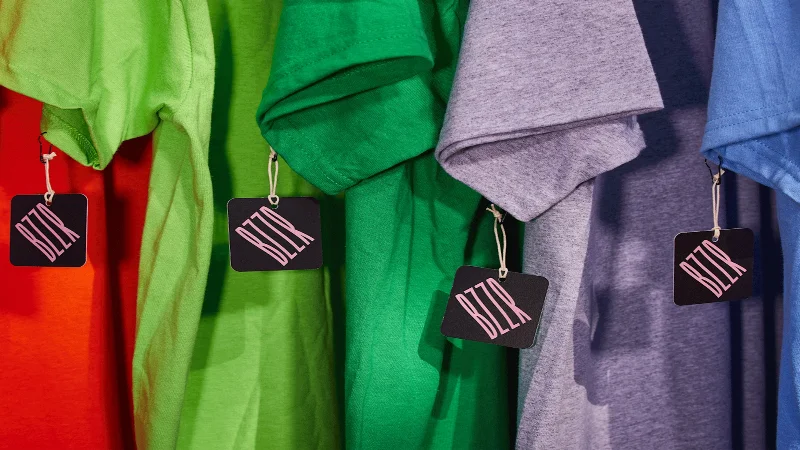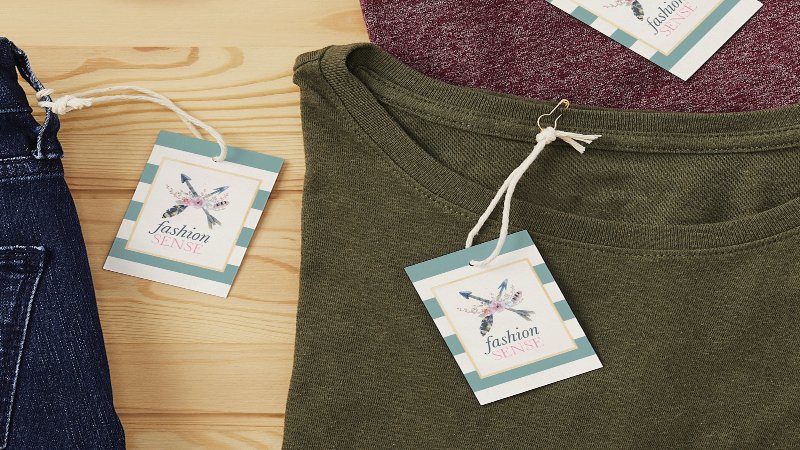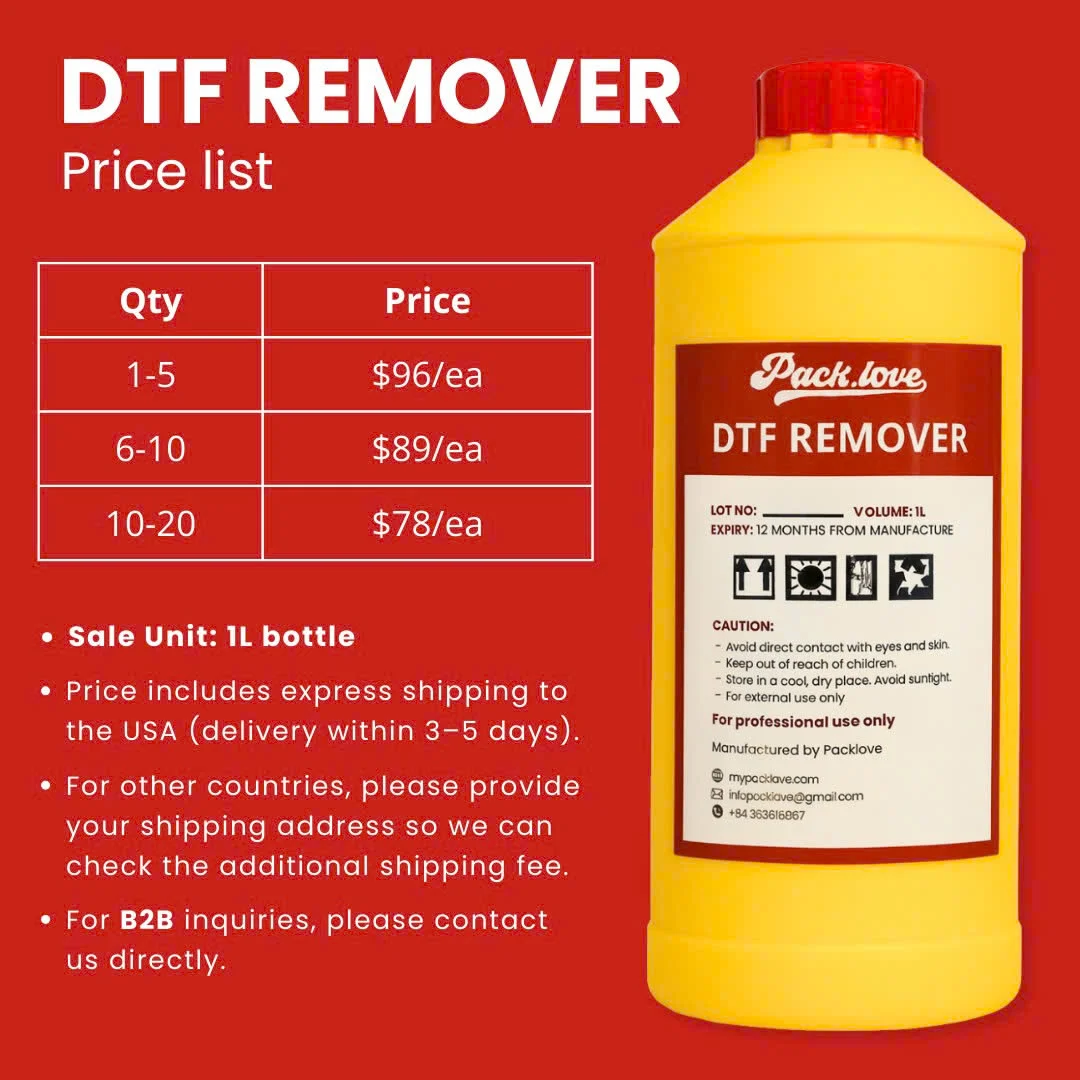Hang Tags: Essential Branding for Small Apparel
For small clothing businesses venturing into competitive retail or wholesale markets, establishing a professional image on a realistic budget presents a significant challenge. Details often feel overwhelming, and the actual impact of elements like hang tags can seem unclear, especially when navigating physical store displays or enhancing e-commerce packaging. Yet, overlooking these small components can be a costly mistake.
This article provides the necessary insights to make informed decisions about your apparel branding. You will gain a clear understanding of what a hang tag is, why its strategic importance extends far beyond simply displaying a price, what essential information (like material, care instructions, or brand story) should be included, and an overview of common material and attachment choices available. Let’s explore these elements in detail!
1. Defining the Hang Tag: More Than Just a Price Marker
A hang tag (often called a product tag or swing tag) is essentially a detachable label attached to merchandise, particularly prevalent on clothing and apparel items within retail settings. Its main purpose, before a customer makes a purchase, is to offer quick information and serve as a branding touchpoint.
Consider this tag part of your comprehensive retail packaging approach; the hang tag acts as a temporary product information system for the potential buyer navigating the store. This function contrasts sharply with permanent labels, like a sewn-in label containing detailed care instructions or a heat-transfer labels, as hang tags are explicitly designed for the consumer to remove once they own the item.

2. The Unspoken Power of Hang Tags for Small Businesses
Think of a hang tag as your brand’s silent salesperson on the retail floor. Long before a customer might interact with staff, the tag provides a visual and tactile introduction. This initial contact significantly shapes the perception of your brand and sets the tone for the entire interaction, forming a crucial part of your merchandise branding.
A well-crafted hang tag does more than just display a price tag; it communicates inherent value. The choice of material, the clarity of the design, and the information presented can subtly suggest higher quality, helping to justify your pricing. Tags can also spotlight key selling points, such as the use of premium fabrics, sustainable practices, or unique design features, directly influencing a customer’s purchasing decision.
Furthermore, hang tags are vital pieces of marketing collateral for building brand identity. Consistent application of your logo, brand colors, and messaging across all hang tags reinforces recognition and helps solidify your brand image in the consumer’s mind. Every tag becomes an opportunity to strengthen your brand’s presence.
Finally, never underestimate the hang tag’s role as an essential information hub. Shoppers actively seek out practical details like size, fit recommendations, fabric composition, and origin. Providing this product information clearly and accessibly on the hang tag meets customer needs efficiently. This also reflects positively on your brand’s transparency and helpfulness.
3. Crafting Your Message: Essential Information for Your Hang Tags
3.1 Must-Haves
- Brand Logo & Name: This is fundamental for brand recognition. Ensure your logo is clearly visible and stylistically consistent with your overall branding. This visual cue instantly connects the garment back to your business.
- Product Information: Size is critical information for shoppers making selections. Including the Material Composition (e.g., “100% Organic Cotton,” “80% Polyester / 20% Spandex”) is equally vital. This manages customer expectations regarding feel and performance and provides initial garment care insights. Note that listing material content is often a legal requirement in many regions.
- Care Instructions: Offer basic, easy-to-understand care instructions, often using standard symbols or concise text (like “Hand Wash Only,” “Lay Flat to Dry”). While comprehensive details usually reside on the permanent sewn-in label, providing essential care guidance on the hang tag is a helpful customer service touchpoint.
- Country of Origin: Displaying the manufacturing country (“Made in USA,” “Made in Vietnam”) is frequently mandated by law for apparel sold in specific markets. Include this information for compliance purposes or if the origin serves as a positive attribute for your brand.
3.2 Strategic Additions for Apparel Branding
- Price: Incorporate the price if your products are sold directly to consumers in a retail environment where visible pricing is standard. However, consider omitting the price if the item is frequently purchased as a gift or if your pricing strategy involves variations across different retailers.
- Website / Social Media: Adding simple social media icons alongside your handles or your website address encourages customers to engage with your brand online, thereby extending the relationship beyond the initial purchase.
- Brand Story/USP (Unique Selling Proposition): A brief tagline or a single compelling sentence (examples: “Ethically sourced fabrics,” “Designed for urban adventurers,” “Timeless style, sustainable future”) can forge an emotional connection and communicate what makes your brand special.
- QR Code: A QR code offers remarkable versatility. This small square can link customers directly to detailed washing instructions, a “shop the look” page featuring complementary items, your brand’s sustainability practices, or simply your main website. A QR code hang tag transforms a static piece of cardstock into an interactive portal, significantly enhancing your apparel branding efforts.
4. Material Matters: A Quick Look at Paper Hang Tag Options
The most frequently encountered material for hang tags is paper, specifically various weights of cardstock. A common and sturdy choice is 300gsm paper stock, offering good rigidity. Within paper hang tag options, you’ll find coated paper, which has a sealant giving it a shinier finish and sometimes added durability, and uncoated paper, known for its matte appearance and more natural texture. Heavier paper stocks are often referred to as cardboard tags.
Selecting the right material hinges on several factors. Your choice should align with your brand aesthetic – for instance, a natural, earthy brand might lean towards kraft paper (a type of unbleached, brown paper stock), whereas a modern, high-fashion line might prefer a sleek, coated white stock.
The material also subtly communicates the perceived quality and price point of the garment. Budget naturally plays a role, particularly when considering custom hang tags with unique shapes or finishes. Increasingly, brands are opting for sustainable choices, utilizing recycled content paper or kraft paper as eco-friendly hang tag materials.
Finally, consider basic finishes like matte lamination, which provides a smooth, non-reflective surface, or gloss lamination, which adds shine and vibrancy. These finishes affect both the tactile feel and the visual appeal of the tag.

5. Connecting the Tag: Common Attachment Methods
Several methods exist for attaching hang tags to garments. Frequently, hang tag string – made from natural fibers like cotton or twine, or synthetic options like polyester – or ribbons are used. These are typically looped through a pre-punched hole in the tag and then secured onto the garment, often through a label or seam.
Another widespread method involves plastic fasteners applied using a tagging gun. This approach is highly efficient for attaching large volumes of tags quickly but can sometimes be perceived as less premium compared to string or ribbon, depending on the overall packaging design.
Less common for new apparel today, primarily due to the potential for snagging delicate fabrics and a somewhat dated perception, are safety pins. However, they might occasionally be employed for specific vintage or industrial aesthetics. The choice of attachment method usually depends on the desired final look that complements the garment and packaging design, the necessary level of security to keep the tag attached before purchase, and the efficiency required during the tagging process in your workflow.
6. Hang Tags vs. Sewn-in Labels: Understanding the Difference
It’s crucial to distinguish between a hang tag (or swing tag) and a sewn-in label, as they serve distinct functions. The primary purpose of a hang tag is temporary; it delivers point-of-sale branding, price, and supplementary information or marketing messages (marketing collateral). In contrast, a sewn-in label is permanent, designed to remain with the garment for its entire lifespan, providing essential long-term details.
Their information focus also differs. Hang tags often highlight branding elements, promotional content, and perhaps basic sizing or material notes. Sewn-in labels, conversely, concentrate on legally mandated information such as complete care instructions, detailed material composition, and country of origin, ensuring compliance and proper garment maintenance over time.
Essentially, the hang tag is part of the initial presentation and is removed by the consumer after purchase, while the sewn-in label provides enduring, often legally required, information directly affixed to the product.

7. Related questions
The cost for custom hang tags fluctuates significantly based on several variables: the chosen material (standard cardstock vs. premium or recycled options), tag size and shape, the number of print colors used, order quantity (price per tag usually decreases with larger orders), any special finishes like foil stamping or embossing, and the attachment method supplied (e.g., pre-strung tags cost more).
Simple, one or two-color designs printed in bulk on standard cardstock can be quite economical, whereas intricate, multi-process tags using luxury materials will naturally command a higher price. Obtaining quotes from several suppliers based on your specific requirements is the best approach.
Yes, absolutely. There’s a growing demand and availability for eco-friendly hang tag options. Common choices include tags made from recycled paper (post-consumer waste content), FSC-certified paper (sourced from responsibly managed forests), unbleached kraft paper (which requires less processing), and even more innovative materials like seed paper (which can be planted) or tags incorporating fabric scraps. Choosing sustainable materials is an excellent way to reinforce an eco-conscious brand identity and appeal to environmentally aware consumers.
7.3 Is there a functional difference between a “hang tag” and a “swing tag”?
Generally, there is no functional difference. The terms “hang tag” and “swing tag” are widely used interchangeably within the industry to describe the same type of detachable tag affixed to merchandise. “Swing tag” perhaps more vividly describes the way the tag often hangs and moves freely from the garment.
7.4 Do I legally need both a hang tag and a sewn-in label?
The focus of legal requirements is typically on the permanent, sewn-in label. Regulations, such as those enforced by the Federal Trade Commission (FTC) in the United States, mandate that certain information – specifically fiber content, country of origin, and manufacturer/dealer identity – must be permanently affixed to most textile and wool apparel products.
Detailed care instructions are also often legally required on a permanent label. While a hang tag can certainly supplement this information and carry branding elements, it usually does not fulfill the legal requirement for permanent labeling because it’s designed to be removed. It is essential to research and comply with the specific labeling regulations for the countries or regions where your apparel will be sold.
Read more:
In summary, hang tags, also known as merchandise tags or clothing tags, serve a purpose far exceeding the simple display of a price. They are indispensable tools in retail branding, acting as key communicators of brand identity, essential product details, and the perceived value of your garments.
Take the time to review your current hang tags or strategically plan for new ones. Consider how this small but significant element can most effectively tell your unique brand story and connect with your target customer. For personalized advice on selecting materials, design considerations, or exploring printing options that align with your brand and budget, consider reaching out to labeling specialists.























